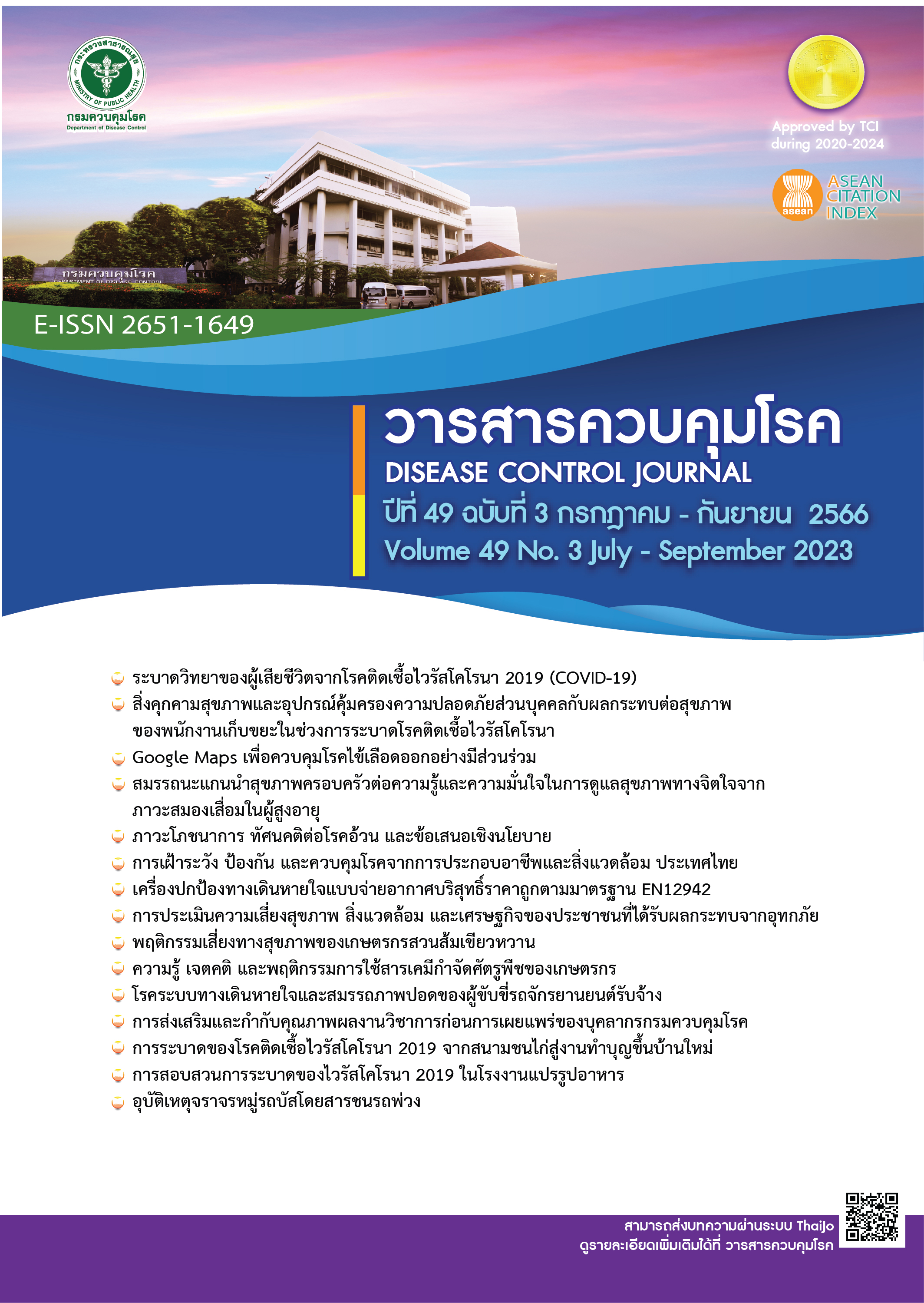Nutritional status, attitudes and policy recommendation on surveillance of obesity among personnel at Chiangmai Rajabhat University
DOI:
https://doi.org/10.14456/dcj.2023.45Keywords:
body mass index, attitudes, obesity, policy recommendationAbstract
The purposes of this mixed methods research were to survey the body mass index and attitudes towards obesity, and synthesize policy recommendation on surveillance of obesity among personnel. A total of 251 personnel who worked at Chiangmai Rajabhat University and 8 stakeholders were participated. The data were collected through questionnaires, informal interview, and stakeholder group operational seminar. Descriptive statistics, multiple linear regression, and content analysis were used to interpret the results. The research reveal findings average BMI of personnel was 23.87+4.33 that 6.37% of the personnel had nutritional status lower than the standard, 41.83% had normal nutritional status, and 51.79% had nutritional status exceeding the standard. The beliefs about obese persons scale (BAOP) mean score was 14.96+4.01. Regarding factor describing body mass index variation, age was satisfied to measure nutritional status (Beta=0.089, p=0.011) with a total variance of 25.2% (p=0.05). In this regard, the stakeholders proposed policy recommendations on surveillance of obesity among personnel including reinforcement attempts to change food consumption behavior, support for regular exercise and screening for body mass index continuously.
Downloads
References
World Obesity Federatio. Prevalence of obesity [Internet]. 2019 [cited 2021 Jul 26]. Available from: https://www.worldobesity.org/about/about -obesity/prevalence-of-obesity
World Health Organization. Obesity and Overweight [Internet]. 2020 [cited 2021 Jul 30]. Available from: https://www.who.int/news-room/fact-sheets/detail/obesity-and-overweight
Aekplakorn W, Inthawong R, Kessomboon P, Sangthong R, Chariyalertsak S, Putwatana P, et al. Prevalence and trends of obesity and association with socioeconomic status in Thai adults:
national health examination surveys, 1991-2009. Journal of Obesity. doi: 10.1155/2014 /410259 (in Thai)
Baker P, Friel S. Processed foods and the nutrition transition: evidence from Asia. Obesity Reviews. 2014;15(7):564-77.
Sakboonyarat B, Pornpongsawad C, Sangkool T, Phanmanas C, Kesonphaet N, Tangthongtawiet N, et al. Trends, prevalence and associated factors of obesity among adults in a rural community in Thailand: serial cross-sectional surveys, 2012 and 2018. BMC Public Health. 2020;20:850.
Tongdee S. An association between obesity and cardiovascular risk diseases among healthcare workers in Somdejphrajaotaksin Maharaj Hospital. Journal of the Phrae Hospital. 2019;27(1):38-50. (in Thai)
Morland K, Diez Roux AV, Wing S. Supermarkets, other food stores, and obesity: the atherosclerosis risk in communities study. Am J Prev Med 2006;30(4):333-9.
Chalao P, Loahasiriwong W, Udompanich S, Prachuntasen K. Situations and factors related to overweight and obesity among health personnel of Sub-District Health Promoting Hospitals, Sakonnakhon Province. The Journal of Baromarajonani College of Nusing, Nakhonratchasima. 2017;23(2):5-17. (in Thai)
Jaitae S. Nutritional status and attitudes towards obesity among personnel at Chiang Mai Rajabhat University [Master of Public Health]. Chiang Mai: Chiang Mai University; 2008. 51 p. (in Thai)
Olshansky SJ, Passaro DJ, Hershow RC, Layden J, Carnes BA, Brody J, et al. A potential decline in life expectancy in the United States in the 21st century. N Engl J Med. 2005;352(11):1138-45.
Daniel WW. Biostatistics: basic concepts and methodology for the health sciences (9th ed). New York: John Wiley & Sons; 2010.
Allison DB, Vincent CB, Harold EY. The measurement of attitudes toward and beliefs about obese persons. Int J Eat Disord. 1991;10(5):599-607.
Ozden D, Sibel AB, Artuner D. Validity and reliability of the Turkish version of the attitudes toward obese persons scale and the beliefs about obese persons scale. Clin Nurs Stud. 2014;2(4):105-17.
Center for Disease Control and Prevention. Body Mass Index (BMI) [Internet]. 2020 [cited 2020 Jun 30]. Available from:https://www.cdc.gov/healthyweight/assessing/bmi/index.html
Matthew BM, Michael AH, Johnny S. Qualitative data analysis: a methods sourcebook. 3rd edition. Arizona: SAGE Publications; 2014.
Chanidtar A. A study of the relationship between dietary habits and body mass index of faculty of medicine Vajira hospital, Navamindradhiraj University personnels. Journal of urban medicine. 2019;63(1):41-54. (in Thai)
Poonnak P. Work ability assessment and related factors among health workers in Chaopraya Yomraj Hospital. Dis Control J. 2021;47(1):58-71. (in Thai)
Kim JH, Sakong J. Life style and perception of obesity of male white collar workers. Korean J Community Nutr. 2006;11(4):479-87.
Rongmuang D. Body weight and shape self-schema, body image satisfaction, and eating disorder behaviors among young adult women, Suratthani. Journal of nurses’ association of Thailand, north-eastern division. 2013;31(4):170-80. (in Thai)
Pakin W. Knoledge, food consumption and nutritional status of softball players, Chiang Mai university 2015 [Master of science (Nutrition education)]. Chiang Mai: Chiang Mai University; 2015. (in Thai)
Downloads
Published
How to Cite
Issue
Section
License
Copyright (c) 2023 Disease Control Journal

This work is licensed under a Creative Commons Attribution-NonCommercial-NoDerivatives 4.0 International License.
Articles published in the Disease Control Journal are considered as academic work, research or analysis of the personal opinion of the authors, not the opinion of the Thailand Department of Disease Control or editorial team. The authors must be responsible for their articles.






